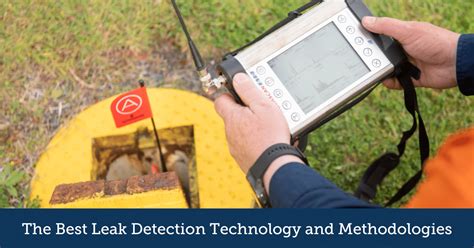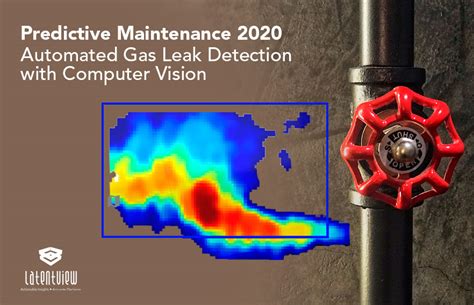Leak Detection Technologies

Leak detection is an essential aspect of various industries, ranging from environmental protection to infrastructure management. The ability to identify and locate leaks promptly is crucial for preventing environmental disasters, ensuring the safety of communities, and maintaining the integrity of critical systems. In this comprehensive article, we will delve into the world of leak detection technologies, exploring the innovative methods and advancements that are revolutionizing this field.
The Evolution of Leak Detection: A Historical Perspective

The journey of leak detection technologies has come a long way since its inception. In the early days, leak detection primarily relied on visual inspections and manual assessments, which were often time-consuming and prone to human error. However, as technology advanced, so did the methods for identifying and addressing leaks effectively.
One of the earliest innovations in leak detection was the development of pressure testing methods. By applying pressure to pipes or containers and monitoring for any drops in pressure, engineers could detect potential leaks. While effective, this method was limited to certain applications and required precise instrumentation.
The advent of acoustic sensors marked a significant milestone in leak detection. These sensors, capable of detecting the unique sound signatures of leaks, revolutionized the industry. By analyzing acoustic data, professionals could locate leaks with precision, even in challenging environments.
Cutting-Edge Technologies in Leak Detection

Today, the field of leak detection boasts an array of cutting-edge technologies, each offering unique advantages and applications. Let’s explore some of the most innovative and promising approaches.
Infrared Imaging for Leak Detection
Infrared (IR) imaging has emerged as a powerful tool in leak detection, particularly in the realm of environmental monitoring and infrastructure assessment. By utilizing thermal imaging cameras, professionals can identify temperature variations caused by leaks, making it possible to visualize and locate even the smallest breaches.
Infrared imaging is particularly effective in detecting leaks in underground pipelines and storage tanks. The technology allows for non-invasive inspections, as it can identify leaks without the need for excavation or disruption to the infrastructure.
One notable application of IR imaging is in the detection of leaks in natural gas pipelines. Natural gas, being a highly flammable substance, poses significant safety risks. Infrared cameras can detect the thermal signature of escaping gas, providing an early warning system to prevent potential disasters.
Ultrasonic Leak Detection: Precision and Speed
Ultrasonic leak detection systems utilize high-frequency sound waves to identify and locate leaks. These systems are highly sensitive and can detect leaks that are virtually inaudible to the human ear. The technology is particularly useful in industries where precision and rapid response are critical, such as the chemical and petrochemical sectors.
Ultrasonic leak detectors work by emitting and receiving ultrasonic signals. When a leak occurs, the ultrasonic waves are disturbed, creating a unique pattern that can be analyzed to pinpoint the exact location of the breach. This real-time data enables prompt action, minimizing the impact of leaks and potential environmental damage.
One of the key advantages of ultrasonic leak detection is its ability to differentiate between different types of leaks. By analyzing the acoustic signature, professionals can determine the severity and nature of the leak, aiding in effective decision-making and repair strategies.
Advanced Sensing Technologies: IoT and AI Integration
The integration of the Internet of Things (IoT) and artificial intelligence (AI) has brought about a new era in leak detection. These technologies enable the development of smart monitoring systems that can continuously collect and analyze data, providing real-time insights and early warnings.
IoT sensors, deployed at various points in a network or infrastructure, can continuously monitor for leaks. These sensors are capable of detecting changes in pressure, flow rates, or chemical compositions, instantly alerting operators to potential issues.
AI algorithms, combined with machine learning, play a crucial role in analyzing the vast amounts of data generated by IoT sensors. These algorithms can identify patterns and anomalies, allowing for the early detection of leaks and the prediction of potential failures.
One notable application of IoT and AI in leak detection is in the water industry. Smart water monitoring systems can detect leaks in water distribution networks, helping utilities conserve water and minimize losses. By analyzing data from multiple sensors, AI algorithms can identify areas of high leak risk and prioritize maintenance efforts.
Real-World Applications and Case Studies
To understand the impact and effectiveness of leak detection technologies, let’s explore some real-world applications and case studies.
Environmental Protection: Preventing Oil Spills
Leak detection technologies play a critical role in environmental protection, particularly in the prevention of oil spills. Advanced sensors and monitoring systems are deployed to detect leaks in offshore oil platforms and pipelines.
One notable example is the use of acoustic sensors to monitor underwater pipelines. By continuously listening for the unique acoustic signatures of leaks, these sensors can provide early warnings, allowing operators to take immediate action and prevent catastrophic spills.
Infrastructure Management: Water Leak Detection
Water leak detection is a crucial aspect of infrastructure management, as leaks can lead to significant water loss and damage to structures. Advanced leak detection technologies are employed to identify and locate leaks in water distribution systems.
In a case study conducted by a leading water utility, the implementation of ultrasonic leak detection systems resulted in a remarkable reduction in water loss. By pinpointing leaks accurately, the utility was able to repair breaches promptly, saving millions of gallons of water annually.
Industrial Safety: Gas Leak Detection in Factories
Gas leaks in industrial settings pose serious safety risks and can lead to explosions and environmental hazards. Advanced leak detection technologies are essential for ensuring the safety of workers and preventing disasters.
In a recent incident at a chemical factory, a combination of ultrasonic and infrared leak detection systems played a crucial role in averting a potential catastrophe. The early detection of a gas leak allowed the factory to evacuate workers and implement safety protocols, preventing a major disaster.
The Future of Leak Detection: Innovations and Trends
The field of leak detection is continuously evolving, driven by advancements in technology and increasing environmental awareness. Here are some future trends and innovations to watch out for.
Drone-Based Leak Detection
Unmanned aerial vehicles (UAVs), or drones, are revolutionizing leak detection in hard-to-reach areas. Drones equipped with infrared cameras and advanced sensors can cover large areas quickly, providing real-time data on potential leaks.
This technology is particularly beneficial for inspecting remote pipelines, power lines, and infrastructure in hazardous environments. Drones can access areas that are challenging or dangerous for human inspectors, enhancing safety and efficiency.
Advanced Analytics and Predictive Maintenance
The integration of advanced analytics and predictive maintenance techniques is set to transform leak detection. By analyzing historical data and patterns, AI algorithms can predict potential leaks and prioritize maintenance activities.
This proactive approach to leak detection minimizes downtime, reduces maintenance costs, and ensures the optimal performance of critical infrastructure. Predictive maintenance also enables a more sustainable approach to resource management.
Smart Materials and Self-Healing Technologies
The development of smart materials and self-healing technologies holds promise for leak detection and prevention. These materials can detect and respond to leaks, sealing breaches autonomously.
For example, researchers are developing self-healing polymers that can repair cracks and breaches in pipelines. These materials, when integrated with leak detection systems, offer a revolutionary approach to leak prevention and maintenance.
Conclusion: Empowering a Safer and Sustainable Future

Leak detection technologies have evolved significantly, empowering industries and communities with the tools to identify and address leaks promptly. From infrared imaging to advanced sensing technologies, the field continues to innovate, ensuring a safer and more sustainable future.
By embracing these cutting-edge technologies, we can mitigate environmental risks, conserve resources, and protect our infrastructure. As we move forward, the integration of IoT, AI, and advanced analytics will further enhance our ability to detect and prevent leaks, paving the way for a resilient and environmentally conscious world.
How accurate are ultrasonic leak detection systems?
+Ultrasonic leak detection systems are highly accurate, capable of detecting even the smallest leaks. These systems analyze the unique acoustic signatures of leaks, ensuring precise location and identification.
Can leak detection technologies prevent all types of leaks?
+While leak detection technologies have advanced significantly, certain leaks, such as very small or intermittent ones, may still be challenging to detect. However, with continuous advancements, the ability to detect and prevent leaks is constantly improving.
What are the benefits of IoT integration in leak detection?
+IoT integration in leak detection offers real-time monitoring, early leak detection, and efficient data analysis. By continuously collecting data from sensors, IoT systems provide valuable insights for proactive maintenance and leak prevention.



